|
|
|
Sort Order |
|
|
|
Items / Page
|
|
|
|
|
|
|
| Srl | Item |
| 1 |
ID:
069880


|
|
|
|
|
| Publication |
2005.
|
| Summary/Abstract |
Coercive diplomacy has long been seen as a viable alternative to war by political decision-makers. There is, however, a long line of credible academic and policy critique-stretching back to the Cold War-that asserts the failures of coercion almost always overwhelm its benefits. Our examination of the 2001-2002 Indo-Pakistani crisis supports the overall analytical consensus that coercive methods, under certain circumstances, accomplish little. We discover that India's use of coercive diplomacy was severely hobbled because of Pakistan's possession of nuclear weapons, strong Pakistani conventional forces, and other geopolitical realities that strongly favored Pakistan. Despite careful attempts by Indian elites to apply the principles of "forceful persuasion" to end the crisis on terms favorable to India (the stronger power in the dispute), the Indian strategy failed to accomplish most of its objectives. Our analysis thereby exposes the limits of coercion and compellance for solving chronic territorial and ideological disputes between enduring rivals
|
|
|
|
|
|
|
|
|
|
|
|
|
|
|
|
| 2 |
ID:
155257
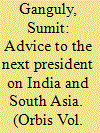

|
|
|
|
|
| Summary/Abstract |
A change in U.S. administrations can often result in significant policy shifts. However, in the case of South Asia, with marked exceptions, U.S. policy has been mostly consistent. That said, the new administration will confront important challenges at global, regional, and bilateral levels that involve South Asia. To that end, the administration will have to deal with questions of climate change, global trade, and transnational terror. It will also have to confront the nettlesome question of the future of Afghanistan as well as the growing religious intolerance and conflict in the overall region. Finally, given India’s significance to the region and beyond, it will need to devise policies designed to place the bilateral relationship on a more secure footing.
|
|
|
|
|
|
|
|
|
|
|
|
|
|
|
|
| 3 |
ID:
060665
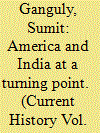

|
|
|
| 4 |
ID:
010803
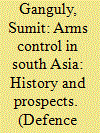

|
|
|
|
|
| Publication |
April 1996.
|
| Description |
65-75
|
|
|
|
|
|
|
|
|
|
|
|
|
|
|
|
| 5 |
ID:
104663
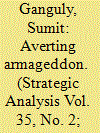

|
|
|
| 6 |
ID:
020627


|
|
|
|
|
| Publication |
Dec 2001.
|
| Description |
3-7
|
|
|
|
|
|
|
|
|
|
|
|
|
|
|
|
| 7 |
ID:
169187
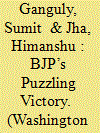

|
|
|
| 8 |
ID:
114507
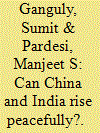

|
|
|
|
|
| Publication |
2012.
|
| Summary/Abstract |
This article provides a brief overview of the theoretical literature on the rise of China, and then explores the implications of the rise of China for the U.S.- China rivalry. It then describes sources of underlying tensions in the Sino-Indian relationship. China and India are not only engaged in a competition for power and influence in Asia, but they are also locked in a particularly contentious border dispute. The authors then argue that economic interdependence may not be enough to offset the sources of conflict in the Sino-Indian rivalry. This holds true in spite of the presence of nuclear weapons by both sides in this dyad. Therefore, a limited conventional war remains a distinct possibility even though it is by no means inevitable.
|
|
|
|
|
|
|
|
|
|
|
|
|
|
|
|
| 9 |
ID:
073374


|
|
|
| 10 |
ID:
048427
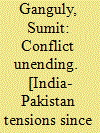

|
|
|
|
|
| Publication |
New Delhi, Oxford University Press, 2002.
|
| Description |
187p.
|
| Standard Number |
0195651901
|
|
|
|
|
|
|
|
|
|
|
|
Copies: C:1/I:0,R:0,Q:0
Circulation
| Accession# | Call# | Current Location | Status | Policy | Location |
| 045781 | 355.020954/GAN 045781 | Main | On Shelf | General | |
|
|
|
|
| 11 |
ID:
053990


|
|
|
|
|
| Publication |
New Delhi, foundation Books, 1997.
|
| Description |
xviii, 182p.
|
| Series |
Woodrow wilson center series
|
| Standard Number |
8175960213
|
|
|
|
|
|
|
|
|
|
|
|
Copies: C:1/I:0,R:0,Q:0
Circulation
| Accession# | Call# | Current Location | Status | Policy | Location |
| 039196 | 355.021809546/GAN 039196 | Main | On Shelf | General | |
|
|
|
|
| 12 |
ID:
089679
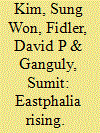

|
|
|
|
|
| Publication |
2009.
|
| Summary/Abstract |
With the power shifting toward the East, Asian preferences and ideas have greter opportunity than ever before to affect world politics, potentially supplanting Western dominance and universal priciples, known for centuries as Wesphalian and post Westphalian concepts, with a new Eastphalian alternative.
|
|
|
|
|
|
|
|
|
|
|
|
|
|
|
|
| 13 |
ID:
158453
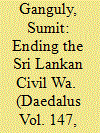

|
|
|
|
|
| Summary/Abstract |
The Sri Lankan Civil War erupted in 1983 and dragged on until 2009. The origins of the conflict can be traced to Sri Lanka's colonial era and subsequent postcolonial policies that had significantly constrained the social and economic rights of the minority Tamil population. Convinced that political avenues for redressing extant grievances were unlikely to yield any meaningful results, a segment of the Tamil community turned to violence precipitating the civil war. A number of domestic, regional, and international efforts to bring about a peaceful solution to the conflict all proved to be futile. A military strategy, which involved extraordinary brutality on the part of the Sri Lankan armed forces, brought it to a close. However, few policy initiatives have been undertaken in its wake to address the underlying grievances of the Tamil citizenry that had contributed to the outbreak of the civil war in the first place.
|
|
|
|
|
|
|
|
|
|
|
|
|
|
|
|
| 14 |
ID:
016076
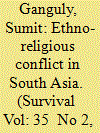

|
|
|
|
|
| Publication |
Summer 1993.
|
| Description |
88-109
|
|
|
|
|
|
|
|
|
|
|
|
|
|
|
|
| 15 |
ID:
096806
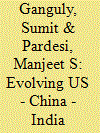

|
|
|
| 16 |
ID:
087511


|
|
|
|
|
| Publication |
2009.
|
| Summary/Abstract |
This paper will provide a survey of India's foreign policy from 1947
to the present day. It is divided into three distinct historical sections.
It will also attempt to explain the underlying reasons for these policies,
India's initial orientation, and subsequent shifts that occurred over
time. The first section deals with the period from 1947 to 1962, the
second from 1962 to 1991 and the third from 1991 to the present. The
choice of these three segments is far from arbitrary. The first period
constituted the most idealistic phase of India's foreign policy under
the tutelage of India's first Prime Minister, Jawaharlal Nehru. The
second began with India's disastrous defeat in the 1962 Sino-Indian
border war. This period saw a gradual shift away from the early idealism
that had characterized the country's foreign policy and the adoption
of an increasingly "self-help" approach to foreign policy while retaining
elements of the Nehruvian rhetoric.1 The third phase began with the
end of the Cold War and the adoption of a more pragmatic foreign
policy hewing closely to the principles of Realism.
|
|
|
|
|
|
|
|
|
|
|
|
|
|
|
|
| 17 |
ID:
060483
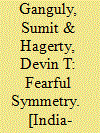

|
|
|
|
|
| Publication |
New Delhi, Oxford University Press, 2005.
|
| Description |
x, 223p.
|
| Standard Number |
0195665864
|
|
|
|
|
|
|
|
|
|
|
|
Copies: C:1/I:0,R:0,Q:0
Circulation
| Accession# | Call# | Current Location | Status | Policy | Location |
| 049445 | 327.5405491/GAN 049445 | Main | On Shelf | General | |
|
|
|
|
| 18 |
ID:
050237
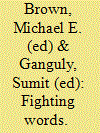

|
|
|
|
|
| Publication |
Cambridge, The MIT Press, 2003.
|
| Description |
xi, 480p.
|
| Series |
BCSIA studies in international security
|
| Standard Number |
0262523337
|
|
|
|
|
|
|
|
|
|
|
|
Copies: C:1/I:0,R:0,Q:0
Circulation
| Accession# | Call# | Current Location | Status | Policy | Location |
| 047556 | 306.4495/BRO 047556 | Main | On Shelf | General | |
|
|
|
|
| 19 |
ID:
153550
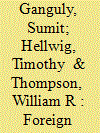

|
|
|
|
|
| Summary/Abstract |
Foreign policy belief systems have received much attention. Yet nearly all work examines attitudes in western democracies, chiefly the United States. The current security environment requires that we ask whether the foreign policy views of individuals in other nations—particularly regional powers—are similar in structure to those found in the US case. This article does so for the Indian case. Drawing on studies of US opinion, we develop a set of claims and test them on an original data set on Indian elites. We make four contributions. First, we show that Wittkopf’s framework applies to the Indian case. Second, we demonstrate how this framework can be made more generally applicable by revising its emphases on different types of internationalism and on rethinking the meaning of isolationist preferences. Third, we place the Indian case in comparative perspective. And last, we model the dimensions of Indian attitudes as a function of domestic ideology. Results of our analyses provide insights into the structure of foreign policy belief systems outside the Global North.
|
|
|
|
|
|
|
|
|
|
|
|
|
|
|
|
| 20 |
ID:
193077
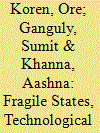

|
|
|
|
|
| Summary/Abstract |
Research on terrorism disagrees on whether terrorist activity is at its highest in collapsed states, which are more hospitable to such activities, or whether terrorism increases in more capable states. We revisit this discussion by theorizing an interactive relationship: terrorists prefer to operate in politically-hospitable states, but their attack frequency within these states increases with greater technological capacity, which allows them to expand their military, recruitment, and financing operations. We analyze 27,018 terrorist incidents using regression and causal inference models, conduct a case study, and find robust support for this interactive logic. Our conclusions outline implications for policy and academic work.
|
|
|
|
|
|
|
|
|
|
|
|
|
|
|
|
|
|
|
|
|